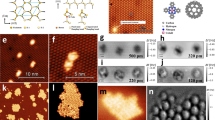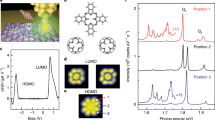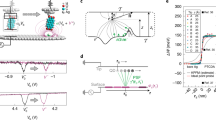Abstract
Scanning tunnelling microscopy and atomic force microscopy can be used to study the electronic and structural properties of surfaces, as well as molecules and nanostructures adsorbed on surfaces, with atomic precision1,2,3,4,5,6,7, but they cannot directly probe the distribution of charge in these systems. However, another form of scanning probe microscopy, Kelvin probe force microscopy, can be used to measure the local contact potential difference between the scanning probe tip and the surface, a quantity that is closely related to the charge distribution on the surface8,9,10,11,12. Here, we use a combination of scanning tunnelling microscopy, atomic force microscopy and Kelvin probe force microscopy to examine naphthalocyanine molecules (which have been used as molecular switches13) on a thin insulating layer of NaCl on Cu(111). We show that Kelvin probe force microscopy can map the local contact potential difference of this system with submolecular resolution, and we use density functional theory calculations to verify that these maps reflect the intramolecular distribution of charge. This approach could help to provide fundamental insights into single-molecule switching and bond formation, processes that are usually accompanied by the redistribution of charge within or between molecules14,15,16.
This is a preview of subscription content, access via your institution
Access options
Subscribe to this journal
Receive 12 print issues and online access
$259.00 per year
only $21.58 per issue
Buy this article
- Purchase on Springer Link
- Instant access to full article PDF
Prices may be subject to local taxes which are calculated during checkout



Similar content being viewed by others
References
Piva, P. G. et al. Field regulation of single-molecule conductivity by a charged surface atom. Nature 435, 658–661 (2005).
Sugimoto, Y. et al. Chemical identification of individual surface atoms by atomic force microscopy. Nature 446, 64–67 (2007).
Ashino, M. et al. Atomically resolved mechanical response of individual metallofullerene molecules confined inside carbon nanotubes. Nature Nanotech. 3, 337–341 (2008).
Albers, B. J. et al. Three-dimensional imaging of short-range chemical forces with picometre resolution. Nature Nanotech. 4, 307–310 (2009).
Gross, L., Mohn, F., Moll, N., Liljeroth, P. & Meyer, G. The chemical structure of a molecule resolved by atomic force microscopy. Science 325, 1110–1114 (2009).
Vitali, L. et al. Portrait of the portential barrier at metal–organic nanocontacts. Nature Mater. 9, 320–323 (2010).
Swart, I., Sonnleitner, T. & Repp, J. Charge state control of molecules reveals modification of the tunneling barrier with intramolecular contrast. Nano Lett. 11, 1580–1584 (2011).
Sommerhalter, C., Matthes, T. W., Glatzel, T., Jäger-Waldau, A. & Lux-Steiner, M. C. High-sensitivity quantitative Kelvin probe microscopy by noncontact ultra-high-vacuum atomic force microscopy. Appl. Phys. Lett. 75, 286–288 (1999).
Barth, C. & Henry, C. R. Surface double layer on (001) surfaces of alkali halide crystals: a scanning force microscopy study. Phys. Rev. Lett. 98, 136804 (2007).
Gross, L. et al. Measuring the charge state of an adatom with noncontact atomic force microscopy. Science 324, 1428–1431 (2009).
König, T. et al. Measuring the charge state of point defects on MgO/Ag(001). J. Am. Chem. Soc. 131, 17544–17545 (2009).
Leoni, T. et al. Controlling the charge state of a single redox molecular switch. Phys. Rev. Lett. 106, 216103 (2011).
Liljeroth, P., Repp, J. & Meyer, G. Current-induced hydrogen tautomerization and conductance switching of naphthalocyanine molecules. Science 317, 1203–1206 (2007).
Grill, L. et al. Nano-architectures by covalent assembly of molecular building blocks. Nature Nanotech. 2, 687–691 (2007).
Wang, W. et al. Manipulating localized molecular orbitals by single-atom contacts. Phys. Rev. Lett. 105, 126801 (2010).
Mohn, F. et al. Reversible bond formation in a gold-atom–organic-molecule complex as a molecular switch. Phys. Rev. Lett. 105, 266102 (2010).
Nonnenmacher, M., O'Boyle, M. P. & Wickramasinghe, H. K. Kelvin probe force microscopy. Appl. Phys. Lett. 58, 2921–2923 (1991).
Burke, S. A. et al. Determination of the local contact potential difference of PTCDA on NaCl: a comparison of techniques. Nanotechnology 20, 264012 (2009).
Sadewasser, S. et al. New insights on atomic-resolution frequency-modulation Kelvin-probe force-microscopy imaging of semiconductors. Phys. Rev. Lett. 103, 266103 (2009).
Enevoldsen, G. H., Glatzel, T., Christensen, M. C., Lauritsen, J. V. & Besenbacher, F. Atomic scale Kelvin probe force microscopy studies of the surface potential variations on the TiO2 (110) surface. Phys. Rev. Lett. 100, 236104 (2008).
Bocquet, F., Nony, L., Loppacher, C. & Glatzel, T. Analytical approach to the local contact potential difference on (001) ionic surfaces: implications for Kelvin probe force microscopy. Phys. Rev. B 78, 035410 (2008).
Kawai, S., Glatzel, T., Hug, H-J. & Meyer, E. Atomic contact potential variations of Si(111)-7×7 analysed by Kelvin probe force microscopy. Nanotechnology 21, 245704 (2010).
Masago, A., Tsukada, M. & Shimizu, M. Simulation method of Kelvin probe force microscopy at nanometer range and its application. Phys. Rev. B 82, 195433 (2010).
Repp, J., Meyer, G., Stojkovic, S. M., Gourdon, A. & Joachim, C. Molecules on insulating films: scanning-tunneling microscopy imaging of individual molecular orbitals. Phys. Rev. Lett. 94, 026803 (2005).
Gross, L. et al. High-resolution molecular orbital imaging using a p-wave STM tip. Phys. Rev. Lett. 107, 086101 (2011).
Gross, L. et al. Organic structure determination using atomic-resolution scanning probe microscopy. Nature Chem. 2, 821–825 (2010).
Bartels, L., Meyer, G. & Rieder, K-H. Controlled vertical manipulation of single CO molecules with the scanning tunneling microscope: a route to chemical contrast. Appl. Phys. Lett. 71, 213–215 (1997).
Jäckel, F. et al. Investigating molecular charge transfer complexes with a low temperature scanning tunneling microscope. Phys. Rev. Lett. 100, 126102 (2008).
Tao, C. et al. Spatial resolution of a type II heterojunction in a single bipolar molecule. Nano Lett. 9, 3963–3967 (2009).
Mohn, F., Gross, L. & Meyer, G. Measuring the short-range force field above a single molecule with atomic resolution. Appl. Phys. Lett. 99, 053106 (2011).
CPMD, v.3.15 (copyright IBM Corp. 1990–2011, copyright MPI für Festkörperforschung Stuttgart 1997–2001).
Acknowledgements
The authors thank J. Repp, R. Allenspach and W. Riess for helpful comments. Financial support from EU projects Herodot and ARTIST, as well as the ERC Advanced Grant CEMAS, is gratefully acknowledged.
Author information
Authors and Affiliations
Contributions
F.M., L.G. and G.M. performed the experiments. F.M. and N.M. carried out the DFT calculations. F.M. wrote the manuscript. All authors discussed the results and commented on the manuscript.
Corresponding author
Ethics declarations
Competing interests
The authors declare no competing financial interests.
Supplementary information
Supplementary information
Supplementary information (PDF 1394 kb)
Rights and permissions
About this article
Cite this article
Mohn, F., Gross, L., Moll, N. et al. Imaging the charge distribution within a single molecule. Nature Nanotech 7, 227–231 (2012). https://doi.org/10.1038/nnano.2012.20
Received:
Accepted:
Published:
Issue Date:
DOI: https://doi.org/10.1038/nnano.2012.20
This article is cited by
-
Precise determination of molecular adsorption geometries by room temperature non-contact atomic force microscopy
Communications Chemistry (2024)
-
High-speed mapping of surface charge dynamics using sparse scanning Kelvin probe force microscopy
Nature Communications (2023)
-
Visualization of π-hole in molecules by means of Kelvin probe force microscopy
Nature Communications (2023)
-
Two-dimensional ferroelectricity in a single-element bismuth monolayer
Nature (2023)
-
Perspective: nanoscale electric sensing and imaging based on quantum sensors
Quantum Frontiers (2023)



